How to Create a Successful Real Estate Mobile App for Your Needs
The real estate market is full of competition. To get ahead of your competitors, you try different strategies. You might improve your service, attract real estate agents to your website, and add new offers. Another thing you might try is creating a mobile application and creating value your competitors can only dream of.
Agencies rapidly jump into real estate app development, and some apps are becoming the Ubers and Facebooks of the real estate market. One example of such an app is Zillow, which currently has over 160 million active users a month.
But you don’t have to be Zillow to be successful in the mobile real estate market. Just think about this: over 90% of real estate firms have websites with property listings. Real estate is already very digitized, but a website is only the first step.
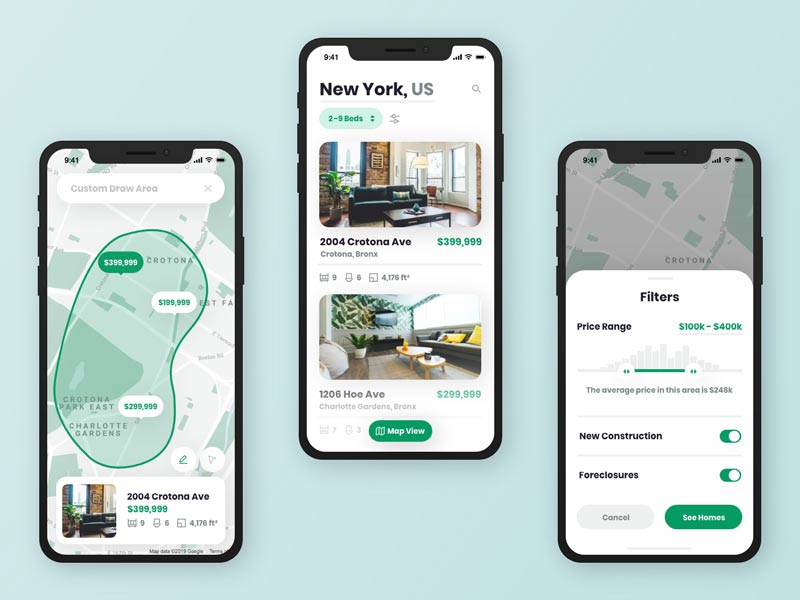
While a website is great for your business, everybody has one. In this article, I’ll tell you about how mobile-specific features can bring value to both your business and your customers. We’ll look at the features necessary for a successful real estate brokers app and answer the question of how much it costs to develop a real estate application.
Why create a real estate app?
According to the National Association of Realtors, 76 percent of home byers use mobile phones or tablets for their home search, and new real estate apps are constantly emerging
But they don’t just go online. They use mobile phones. In fact, the majority of people currently use mobile phones for almost everything, from ordering food to searching for homes. According to statistics, more and more people are accessing the internet via mobile phones.
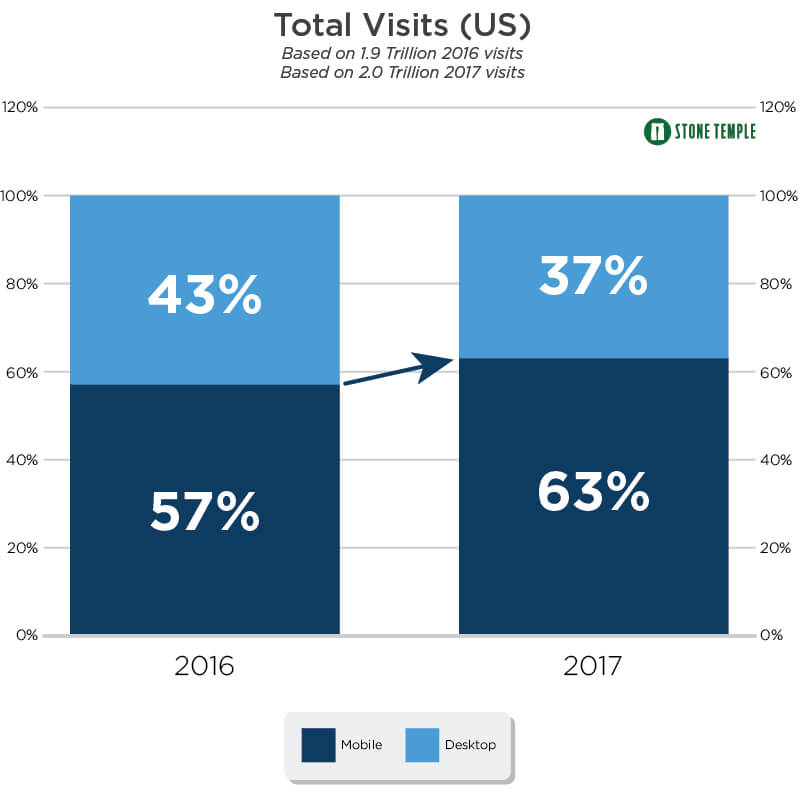
Moreover, most of the time spent on mobile devices is dedicated to mobile applications.
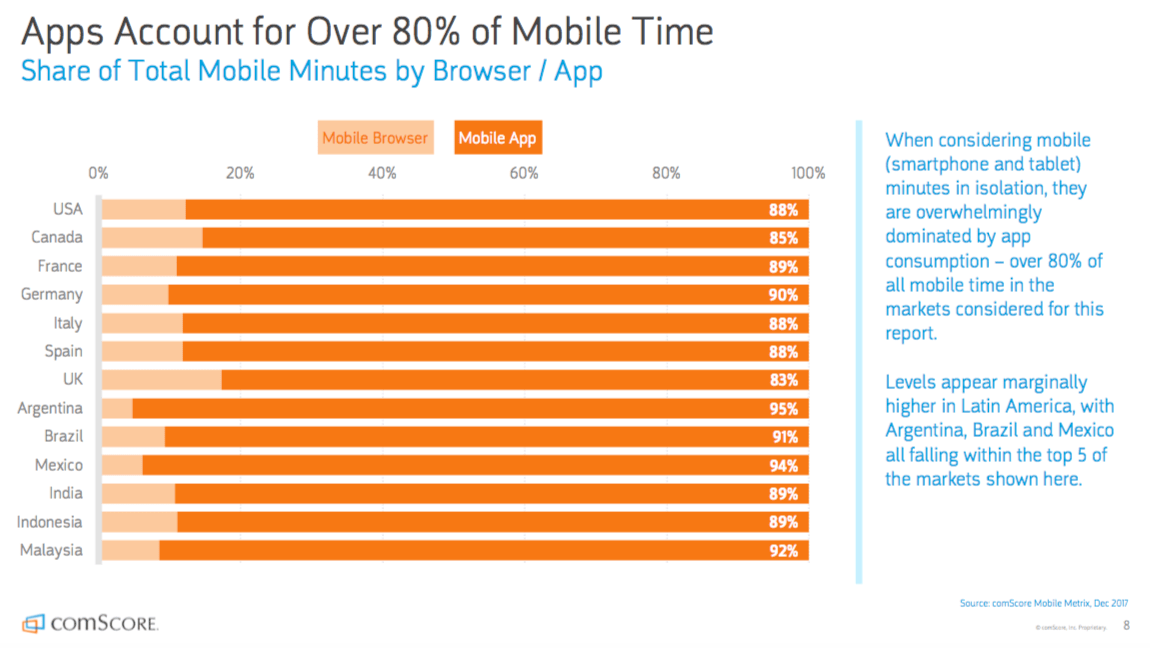
Why do people spend so much time in apps rather than on mobile websites? First, apps are faster and better adapted for mobile devices.
Second, apps have access to a mobile phone’s hardware, which allows for lots of mobile-specific features. For example, you can send users targeted push notifications, use mobile devices’ hardware like cameras, and even use augmented reality that is now possible only in mobile apps.
58% of Millennials and 46% of Generation X homebuyers have found their home on a mobile device, compared to 33% of Baby Boomers
Remember that as your target audience changes and a new generation begins to buy houses and become your clients, a mobile presence will become more important.
I have numbers to back this up: according to research by the National Association of Realtors, 58% of Millennials and 46% of Generation X homebuyers have found their home on a mobile device, compared to 33% of Baby Boomers.
Let’s find out how to build a real estate app.
Trulia vs Zillow
Trulia and Zillow are two most popular real estate websites in the United States. They both have mobile apps, and boast millions of unique monthly users. Currently they’re parts of the same company, as the Zillow Group bought Trulia for $3.5 billion in 2015. However, for users these are still different products.
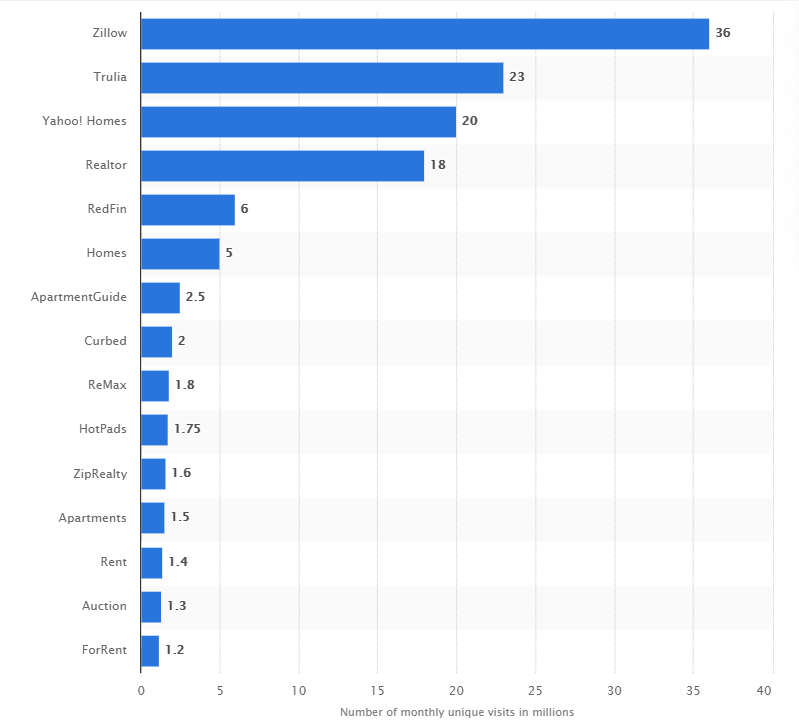
Source: Statista
Both Zillow and Trulia are very similar: they provide users with real estate databases full of houses and apartments for rent and sale. Their core features are listings with photos and detailed desctiptions are rather similar. However, there are some key differences.
Zillow provides estimates of each building based on market and publicly available information. This is called Zestimates. This helps both users and agents to learn more about property market value and make sure they get the best possible deal. A Zestimate is merely a suggestion and a starting point which realtors and sellers can use as a reference to put prices on their estates.
Trulia provides more information on the neighbourhoods, giving users access to 34 different maps that show schools, average level of income, crime rate and other characteristics of a particular area. This helps users to not only choose the property, but learn more about the environment around it. Trulia also offers great tools for calculating monthly costs for mortgage payment, taxes and insurance.
Real estate mobile app development strategy
The set of features for your application depends on your business model. You may want to create real estate app platform where independent real estate agents and brokers put properties up for sale or rent and where buyers and renters look for houses.
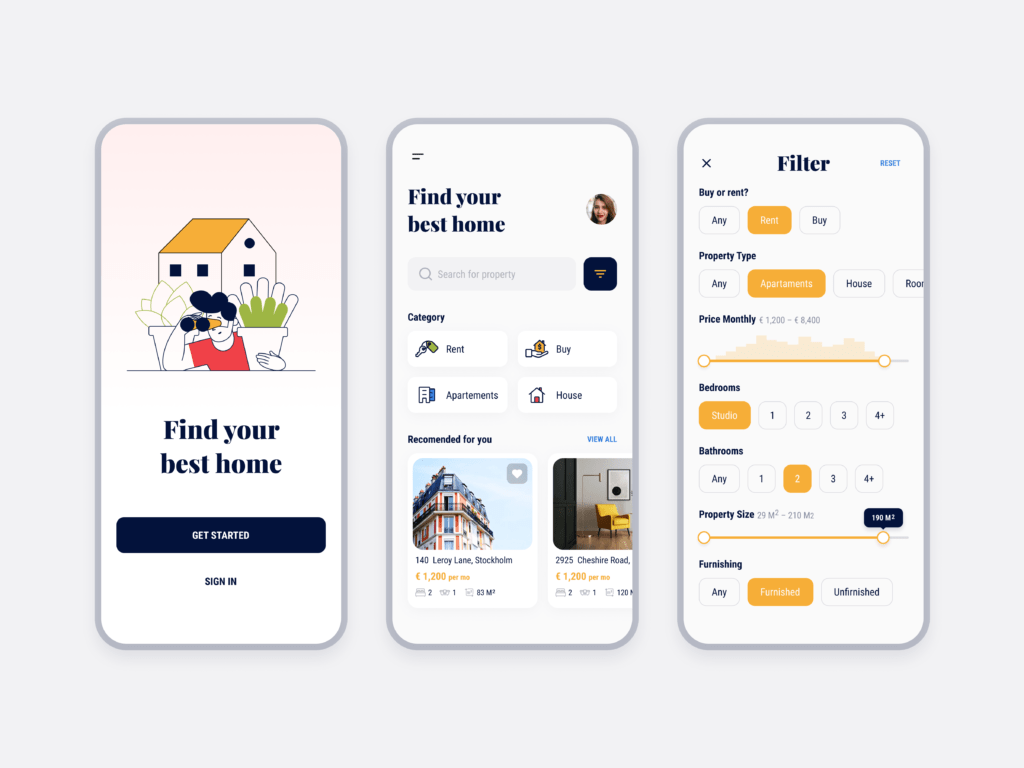
Another option is to make a mobile app that only features listings. If you have a big real estate agency with many options or niche offers, you can create an app your clients will use. You need to do thorough market research to find out whether your clients would like to have a mobile app and whether it will actually be profitable for you. To test whether an app is profitable for your business, you can use an app builder for an MVP, but its functionality won’t probably be sufficient for your business needs.
To separate user roles, you can either do two separate apps, or to make a two different user roles in one mobile app. To moderate your platform, the best practice is to create a web app for administrators.
Features for a real estate platform support three user roles: agents, buyers, and administrators. If you want to create a mobile app specifically for your real estate agency, you can just pick the features you’ll need and calculate the price of real estate app development later in this article.
Real estate app tech stack
To create a real estate app, you need a powerful server. The following list provides useful tools that can be used when developing real estate applications:
- CoreData or Realm frameworks – Manages the list of stored properties.
- Google Places API – Provides users with detailed information about the area and the surrounding area.
- Firebase SDK or Apple Push Notifications Service – Enables push notifications.
- SimpleRets, iHomeFinder, Spark APIs – normalizes MLS data streams.
- Facebook SDK – integrates the Facebook login option.
- Zillow API – Provides access to area information and Zillow listings.
- Mapbox or Google Maps API – Creates custom maps.
- Aviation Informatics Community, Spatial Neighborhood API – Provides demographic data and information about specific areas.
- Java or Kotlin is an Android development language.
- Swift or Objective C is an iOS development language.
- Amazon S3 is a cloud storage for ads.
Top 4 technology trends in real estate in 2023
Real estate industry has become extremely complicated, as prices for real estate are the most sensitive to any changes in economics. Also, the demand for housing is increasing, so people seek for more effective ways to connect owners, agents and buyers along with renters. These are technologies modern real estate companies use to make their service more effective.
1. Big data
Big data allows to store and process large amounts of data, and gather information about each user to later predict their behavior and decisions. Big data is used in real estate in pair with artificial intelligence to perfect suggestinons and offer users exactly what they’re looking for.
2. Blockchain
Due to its transparency, blockchain is widely used to prevent fraud in real estate business, as it allows to double-check all the documents and make sure nobody is able to make any changes to them. Blockchain also helps to reduce the amount of red tape and avoid endless mediators that charge fees for their services.
3. Artificial intelligence
Is used mostly for analysing the user’s preferences and requirements to make the most accurate and personalized suggestions. This allows a user to save time. Also, AI can help with property management by processing maintenance requests, tracking changes in listings, prices, etc. AI can analyse the market prices, and also help with risk management.
4. Augmented and virtual reality
Augmented reality helps to increase sales by visualizing the property to potential renters or buyers and help them imagine how it will look like after the purchase. AR is perfect for remote virtual tours around the property: this helps both buyers and sellers save time and enhance property marketing.
Top 14 must-have features for real estate apps for agents and buyers
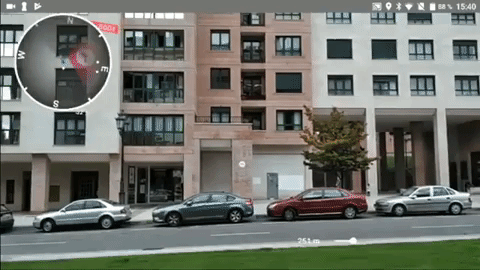
Here we’ll explore best features for real estate apps for agents and their clients. I’ll start with common features and then tell you about features specific for agents and buyers. To separate these features from each other, you can either do two separate apps, or to make a two different user roles in one mobile app. To moderate your platform, the best practice is to create a web app for administrators.
So, how to develop a real estate app like Zillow, or even better?
Onboarding
Onboarding should be as easy as possible. That’s why you might want to use social media accounts for signing in. You can also register users by phone number or email, but don’t make onboarding compulsory at the very beginning. Allow users to have a look at your app first.
Personal profiles
Personal profiles are different for buyers and agents. Agents should be able to see their properties, schedules, and profiles of potential buyers who have contacted them. Buyers should see a list of properties they liked while browsing listings.
Database and listings
A big database is crucial for your application. It’s a core feature, and for your app to be successful, you’ll need to have lots of listings for potential buyers. Information about properties in the database should be reflected in listings.
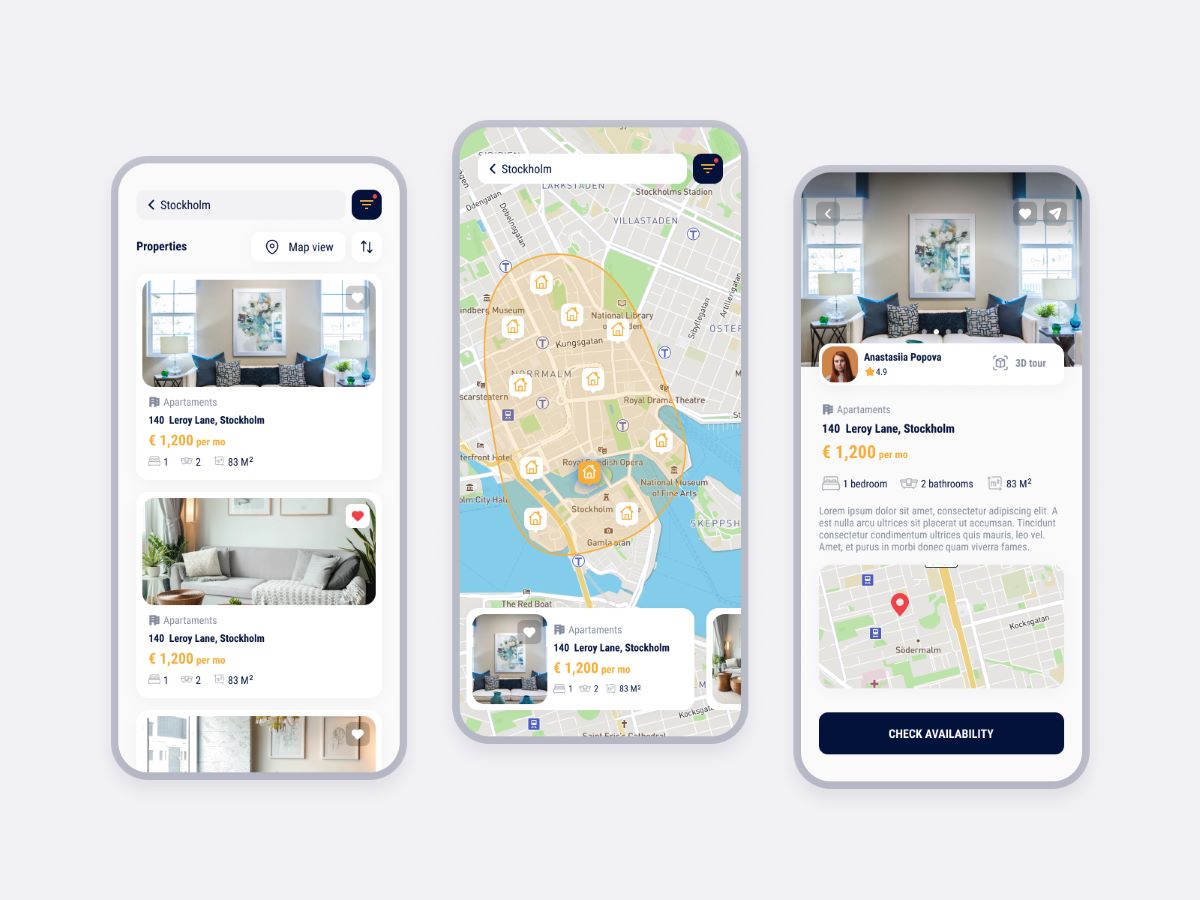
Make sure listings give the information the buyers are most interested in, including pictures.
Categories and filters
Finding the right property is the most difficult part of the whole process of buying or renting a house. That’s why you need advanced сategories and filters for your mobile app, as they’re the primary tools that buyers will use.
Property profiles
A property profile should include extensive information about the property. Showcase more photos, give a description of the property, list a price for purchase or rent, and let homebuyers call a real estate agent to ask about the property.
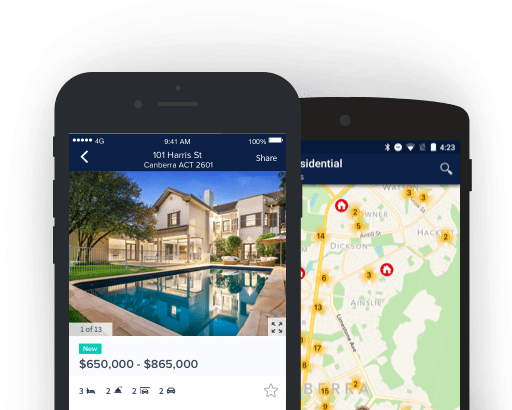
Favorites
It’s important to give customers the ability to shortlist properties they like to make the decision easier. Favorites should be visible in a user’s profile or in a menu.
Calendar
Integrate a calendar into your mobile application so that both real estate agents and clients can schedule appointments and link them to properties.
Price calculator
Add a calculator to your mobile app to help users find out the final price of a home including loan interest in different banks. The calculator should be detailed, allowing users to choose the price of a home, their initial payment, the loan interest and the loan repayment period.
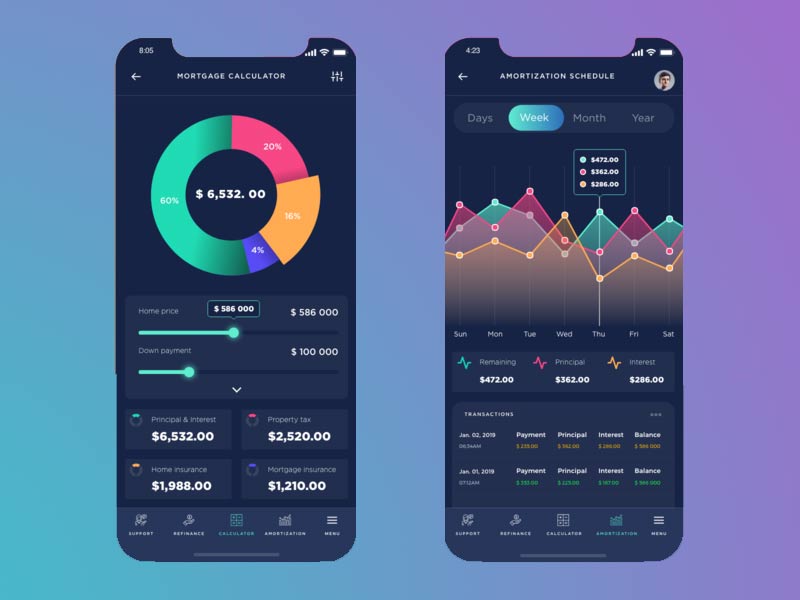
Call button
A website or mobile app is just a first step toward buying a house. To move users forward through the sales funnel, you need to let them call an agent. You can offer users different ways to connect to an agent:
- Call button
- Callback button
- Online chat
- Request for a consultation
Maps
Maps can provide lots of valuable information to homebuyers. Apart from showing the locations of properties, you can also show data and statistics across different areas. These statistics aren’t very hard to find: usually all you have to do is research on government websites before you create your own real estate app.
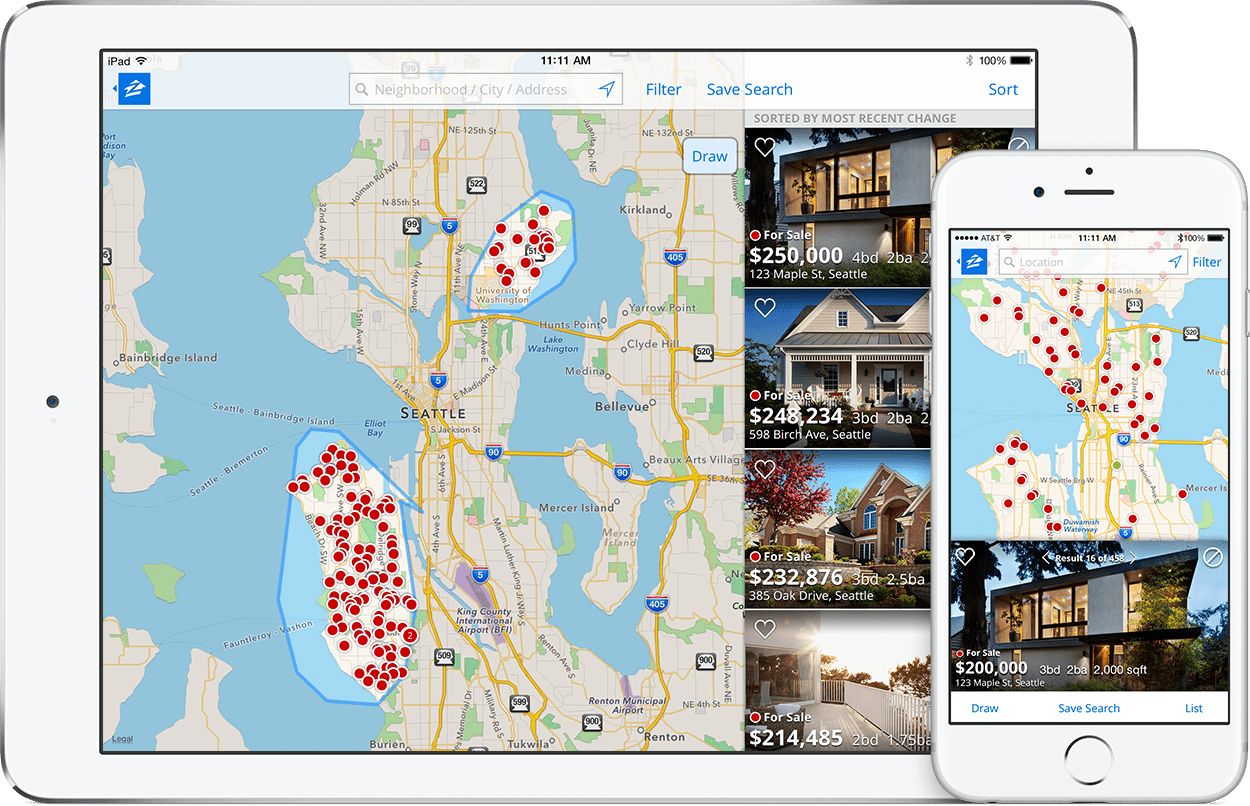
You can show information about average incomes, crime rates, the risks of natural disasters, infrastructure, and school locations on your maps. All this will help users to make decisions.
Push notifications
Push notifications achieve two important goals. First, they retain users and remind them of your app so they use your application more frequently. Second, they allow you to reach out to users and notify them of important events, such as:
- Price changes
- New properties in an area
- Any updates on properties
Push notifications should be personalized: send only relevant messages that will bring value to users.
Analytics
Analytics is crucial for any kind of application. Whether you have a platform where real estate agents meet their customers or a mobile app for your real estate agency only, you need to see how your business is growing.
If you have a realtor app for Android and iOS, you need to gather analytics from both apps and compare them, as the user behavior is different for these two user categories.
Analytics can give you valuable insights on your app’s performance, but more importantly, they can show you how successful your business model is. Analytics gives you information about your target audience so you can tweak your strategy according to users’ preferences.
Real estate agent profile
Real estate agent apps should have a database of brokers’ profiles, where they can show their credibility, properties and ratings. This will help an agent to sell his services and also manage the clients.
An agent should be able to add a property into their own catalog, add photos, description and edit it if needed. To make your platform credible, you want to come up with a verification strategy, so that buyers know exactly what they get when they contact an agent on a certain property.
Real estate agents listing
Apps for real estate agents and buyers should have not only property listings, but also agents listings. They can be done according to the property listing template with some changes. A picture, short description, number of properties, location, rating and sources of credibility: all this should be present in a listing.
Real estate mobile app development cost
The cost of real estate mobile app development depends on three main things:
- Feature set
- Technologies
- Hourly rate of the development company you hire
Hourly rates usually depend on the location of the real estate app development company you hire. For example, you can develop your application in the US and pay over $150 per hour. Or you can outsource development to a country in Eastern Europe and pay $35 per hour.
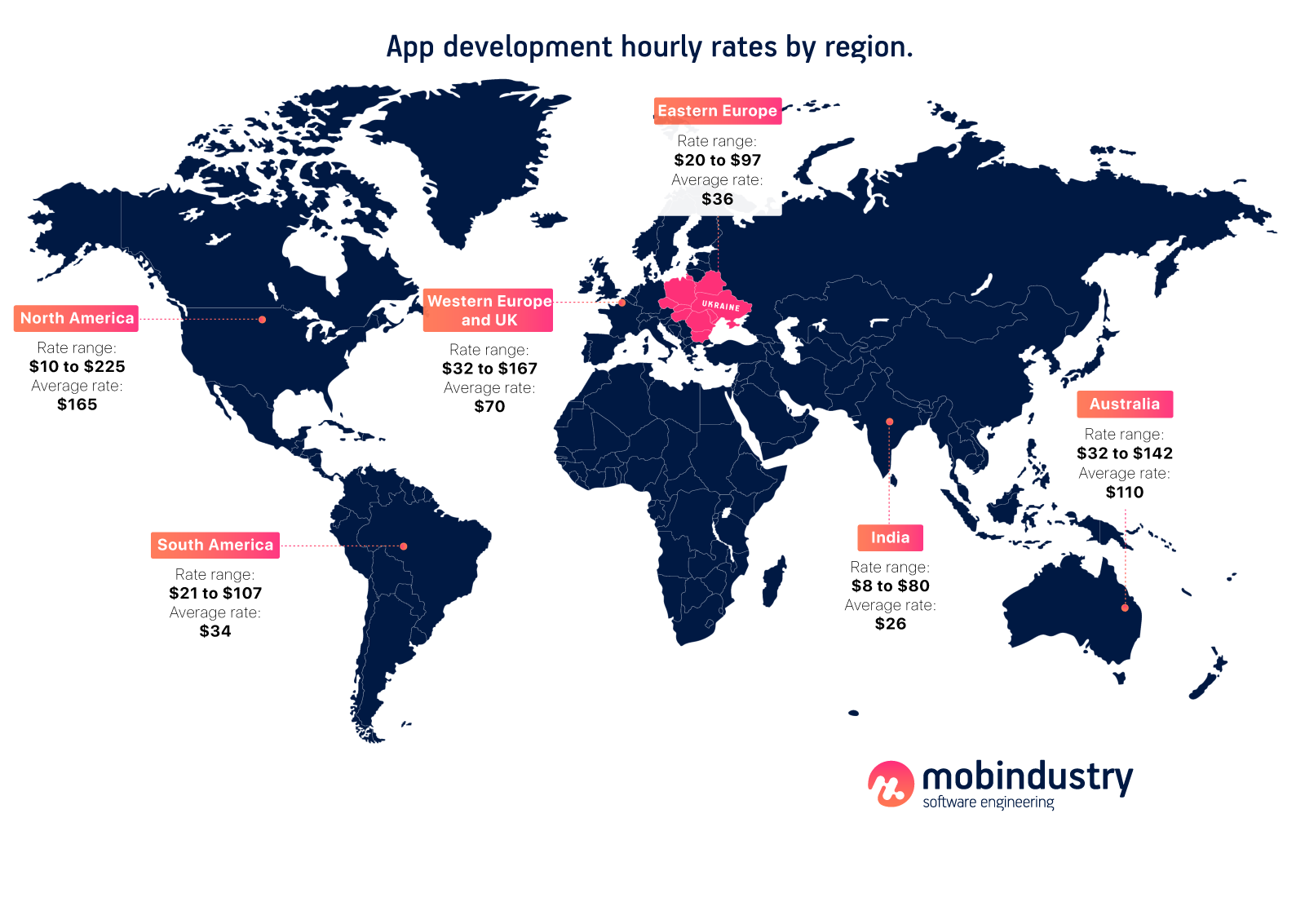
Even for small projects, you can save money that you can then invest in marketing and support. If you want to create two real estate applications for Android and iOS, you’ll need to multiply your budget by 1,9.
Now we’ll see how many 8-hour days of development it takes to develop each feature we’ve mentioned in this article. You can choose the features you need and calculate the approximate price of your real estate mobile app. Note that setup, communication, business analysis, and real estate app design will require additional investment.
| Feature | Estimate in days |
| Onboarding | 3 – 6 |
| Personal user profile | 1 – 3 |
| Properties catalog | 3 – 5 |
| Categories | 1 |
| Filters | 3 – 6 |
| Property profile | 2 – 4 |
| Favorites | 2 – 3 |
| Calendar | 3 – 5 |
| Price calculator | 3 – 5 |
| Call button | 1 |
| Online chat | 5 – 10 |
| Callback button | 1 |
| Maps | 4 – 12 |
| Push notifications | 2 |
| Analytics | 2 – 4 |
| Real estate agent profile | 3 – 5 |
| Add a property | 3 – 6 |
| Real estate agents listing | 2 – 4 |
Final thoughts
There are lots of real estate companies out there, and it’s becoming harder to attract new clients because the deal cycle is usually rather long and the competition is growing.
Making offers and creating an easy process of choosing a property is what makes a real estate company stand out. As current millennials are already becoming a big part of the audience for real estate companies, you need to start speaking their language. And it’s mobile.
To find out more about real estate app development solutions, contact us. We’ll gladly consult on whether your real estate business could benefit from a mobile app and how you can monetize and market one once you create an app for a real estate company.
If you’re planning to make your own real estate app, you might as well add Mobindustry to your list of real estate mobile app developers. To find out more about our company and how we work with our clients, check this article.

